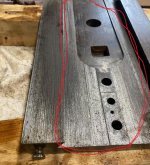Bought this beauty about a month ago to accompany my 10ee. I came with all the original chucks, faceplates, steady rest, taper attachment and the original manual! Also came with a Hardinge collet chuck. I have the original motor which is out of the machine, because it was replace with a new one some time ago....
I do have some questions. There is a forward/reverse drum switch next to the start/stop switch. I'm assuming this is not original, but could someone confirm? If it is not, can someone tell me how the forward/reverse functioned? Basically looking to see how the original electrical was done?
Hoping this link to my Google Photos album will work. Click link below to access pictures.
Monarch 18” CBB Lathe - Google Photos
I do have some questions. There is a forward/reverse drum switch next to the start/stop switch. I'm assuming this is not original, but could someone confirm? If it is not, can someone tell me how the forward/reverse functioned? Basically looking to see how the original electrical was done?
Hoping this link to my Google Photos album will work. Click link below to access pictures.
Monarch 18” CBB Lathe - Google Photos












